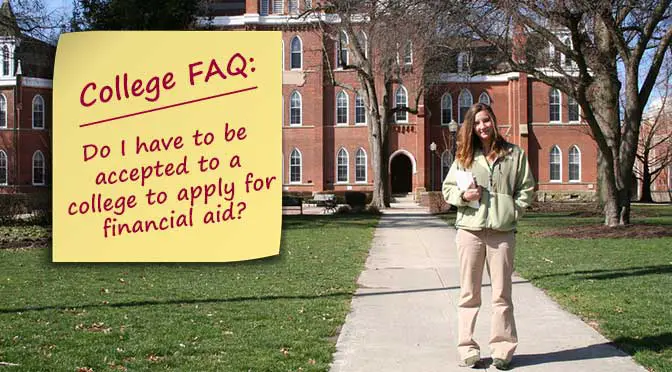 No. You don’t have to be accepted to a college to apply for financial aid. You can submit the Free Application for Federal Student Aid (FAFSA) and the College Service Scholarship PROFILE (CSS PROFILE) any time after October 1 of your senior year. You do need to be admitted to a school actually receive financial aid.
No. You don’t have to be accepted to a college to apply for financial aid. You can submit the Free Application for Federal Student Aid (FAFSA) and the College Service Scholarship PROFILE (CSS PROFILE) any time after October 1 of your senior year. You do need to be admitted to a school actually receive financial aid.
Different deadlines for applying for financial aid
The deadline for submitting the FAFSA is June 30. However, most schools will have a priority deadline for financial aid. You will need to apply by this deadline so that you will know your financial aid award before you have to accept. Accepting before you know your financial aid award is generally not a good idea unless you have no problem paying full tuition.
The FAFSA is also used by many states for awarding state financial aid. You’ll need to check on each state’s deadline so you don’t miss opportunities for financial aid. Not all state financial aid is need based. Some states like Florida and Georgia have extensive merit base programs. You can find out more about individual state deadlines at the Student Aid website. The National Association of Student Financial Aid Administrators list the programs available by state.
The early bird gets more financial aid
Ultimately, it is in your best interest to submit the FAFSA and any college specific forms as soon as possible for a variety of reasons. Many colleges will notify you of your acceptance before the priority deadline for financial aid. The sooner they have your financial aid application, the sooner they notify you of your award, and the sooner you can decide if you want to attend the college.
Colleges may award aid as applications are completed. This can apply to both institutional and federal money. In the case of the Supplemental Education Opportunity Grant, colleges often do not receive enough funding to provide grants to all eligible students. Therefore, the later you wait to submit the FAFSA, the less likely you are to receive some forms of need-based aid or institutional aid.
Some colleges require a completed financial aid application before awarding any merit aid. Getting your award earlier can allow you to appeal decisions before you have to send in your acceptance.
You only submit the FAFSA once a year
Even if you apply to multiple colleges, you only have to submit the FAFSA once. The federal government processes the information and assigns you a score. This information is then provided to all the colleges you list on your form. You don’t even have to have applied to the colleges yet to list them on the FAFSA.
Depending on the school, you may be required to submit the CSS PROFILE financial aid application. This is administered by the College Board and the school uses it to award its institutional aid. You still have to submit the FAFSA if you want to qualify for any federal aid including student loans.
The thing to keep in mind is that you will have to complete the FAFSA every year. This means that your financial aid can be adjusted from year to year depending on your financial situation. It’s important to understand that the amount of financial aid you qualify for changes depending on the cost of the school and the number of siblings attending college. A student who doesn’t qualify for anything but a student loan one year may qualify for more grant aid the next year as another sibling starts college. It also changes depending on the cost of the college. Students at more expensive colleges qualify for more financial aid than those at less expensive schools.
It’s getting easier to complete the FAFSA
You can always get help completing the FAFSA. However, technology has been making it easier for students and families to complete the FAFSA. Students and parents can use the IRS Data Retrieval Tool which will automatically transmit the required tax information to the online application. Another advantage to completing the application online is that as families complete the form, it will automatically skip questions the family doesn’t need to complete and only show the relevant ones.
There will be some significant changes to the FAFSA starting in October of 2022. The number of questions will decrease from 108 questions to only 36 questions. Families won’t have to use the IRS Data Retrieval Tool since the FAFSA will import the information automatically. Students below a certain percentage of the poverty line will automatically qualify for the Pell Grant. The six-year limit on Federal Direct student loans will also be going away.


